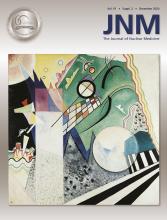PET is firmly established as a valuable tool in clinical practice. There is no question that 18F-FDG PET imaging is the most sensitive method for staging of cancers. In addition, PET perfusion imaging is the most accurate method for selecting patients who will benefit from a heart catheterization procedure. Finally, amyloid imaging is taking hold as a valuable tool in the differential diagnosis of Alzheimer disease, and new applications, such as the evaluation of inflammatory processes in rheumatoid arthritis, are constantly emerging.
The evolution of PET from a prototype physiologic measurement tool to its widespread use in diagnostic medicine is the result of several technologic innovations in combination with a constantly increasing armamentarium of PET tracers, enabling the assessment of an ever-increasing number of molecular processes. Although tracer development is important in the search for more selective diagnostic procedures, there is little doubt that the field would not have survived without 18F-FDG. Having acknowledged the importance of radiochemical developments, this contribution will focus on technologic developments, with the key innovations summarized in Table 1.
Key Innovations in Development of PET
Clearly, none of the developments listed in Table 1 would have been possible without the initial construction of a working PET scanner. Although there had been earlier attempts, which in general were not successful because of a too-limited number of projections, the first working PET scanner was constructed by the St. Louis group (1,2). Subsequently, 2 key scientists of this team (Phelps and Hoffman) moved to Los Angeles, where a PET scanner was built (3) that was subsequently commercialized.
The first generation of commercial PET scanners consisted of relatively large sodium iodide crystals. To achieve a sufficient number of projections, detectors underwent rotational and translational movements. For a complete scan, the mechanical movements required approximately 30 s, precluding acquisition of short scans at the beginning of a dynamic scan. Next, the emergence of new crystal materials made it possible to construct scanners with stationary rings and with sufficient sensitivity to enable acquisition of dynamic scans. To limit scatter in subsequent multiring devices, tungsten septa were positioned between rings. When methods to correct for scatter improved, it was possible to remove these septa, allowing for so-called 3-dimensional scans (4), which meant a major increase in sensitivity.
The developments mentioned above all happened in a period of approximately 20 years when PET was embedded primarily in the research domain (apart from its use in assessing myocardial viability). In the mid-1990s, however, a new development—the possibility of surveying the whole body (whole-body scan) (5)—rekindled interest in oncology, and many subsequent studies showed that 18F-FDG PET was the most sensitive method to detect metastases, with obvious (and now well-known) implications for staging and preventing futile surgery.
Whole-body 18F-FDG PET for tumor staging became the key factor in establishing PET as a clinical diagnostic tool, and at the end of the 1990s there was a sharp increase in PET sales. Despite the progress in staging, it was not always easy to determine the exact sites of lesions, as the transmission scan did not provide enough anatomic information and coregistration with a separately acquired CT scan proved to be difficult, at least in some parts of the body. In addition, although the transmission scan may be the purest and most accurate method for measuring tissue attenuation, it suffers from poor statistics. Consequently, the duration of the transmission scan became a burden both for the patient and for patient throughput.
The solution for this problem was as brilliant as it was simple. David Townsend (then at Geneva) and Ron Nutt (from CTI, the main PET manufacturer at the time) had developed a cheaper type of PET scanner, one with a partial ring of detectors (which were and still are the most expensive part of a scanner) rotating around the patient. Given the continuous call for more anatomic information for staging purposes and the realization that there was a lot of empty space in this rotating PET camera, they had the idea to use the opposite part of the ring for mounting a CT scanner.
The idea to mount both PET and CT on the same ring proved to be less practical, but they pursued their idea by putting 2 separate rings together, resulting in the first combined PET/CT scanner. An article about this scanner was published in The Journal of Nuclear Medicine and became the highest-cited paper in that decade (6).
Interestingly, the rotating PET camera, developed to save costs, was not a commercial success, but the combination of PET and CT in a single scanner was. No longer were PET scanners sold primarily to research groups; instead, the combination of PET and CT scanners in a single machine became a driving force in making PET attractive for clinical sites. All subsequent full-ring PET scanners were equipped with a CT component, and within 10 years after the description of the first PET/CT scanner, it was no longer possible to buy a PET-alone scanner.
The next major innovation in PET was the so-called total-body PET scanner (7). It is needless to say that these scanners will also be equipped with CT, illustrating that PET/CT is not a short-lived hype but an idea—a development that will stay with us for the foreseeable future.
DISCLOSURE
No potential conflict of interest relevant to this article was reported.
- © 2020 by the Society of Nuclear Medicine and Molecular Imaging.
REFERENCES
- Received for publication July 1, 2020.
- Accepted for publication August 27, 2020.







